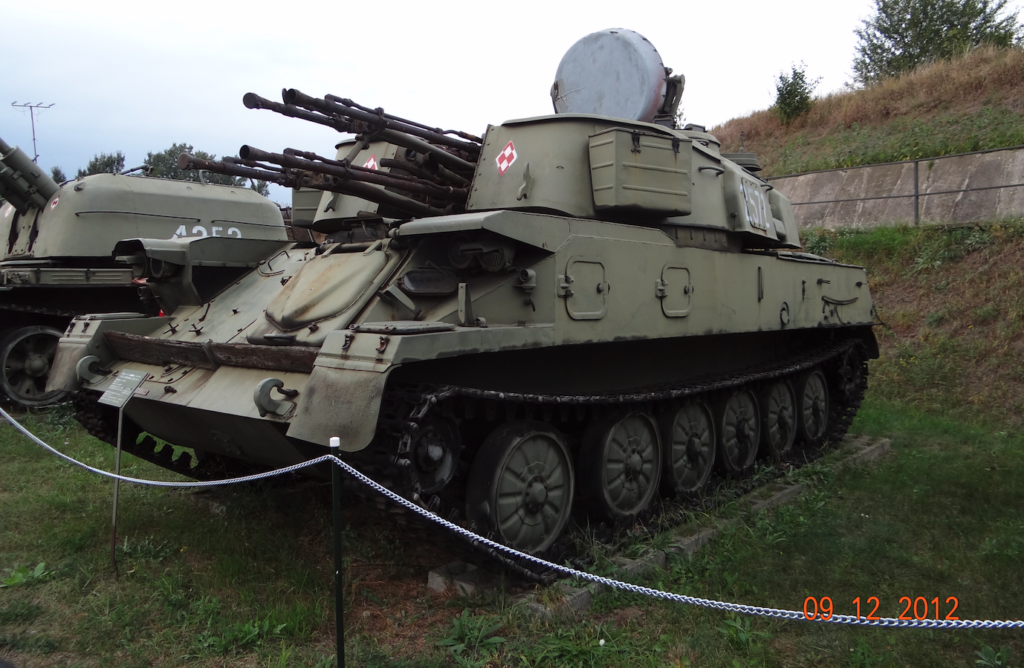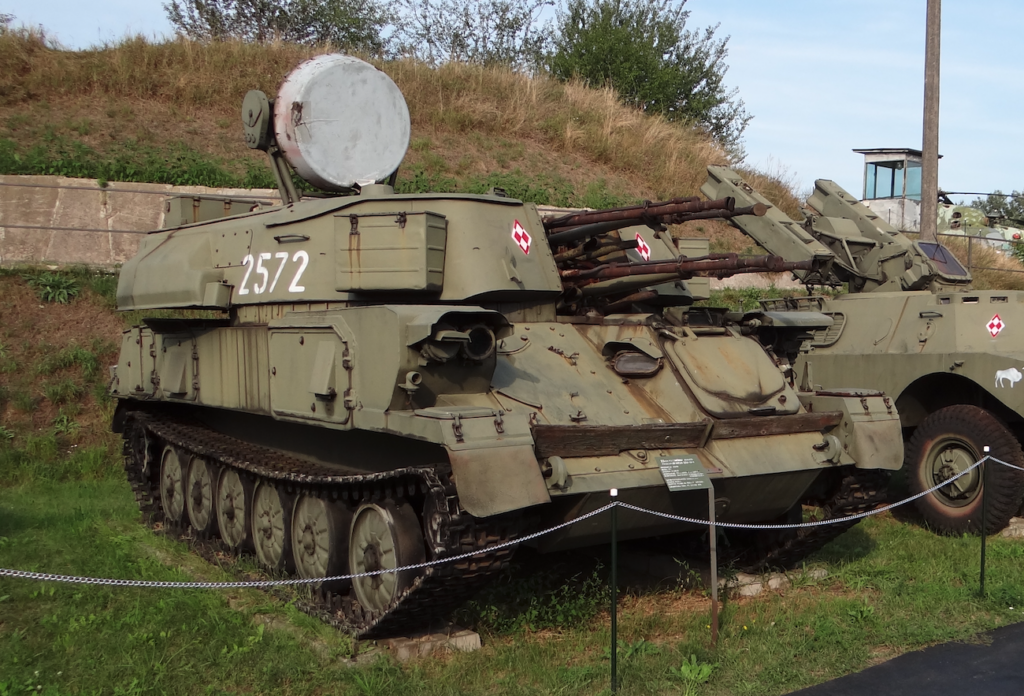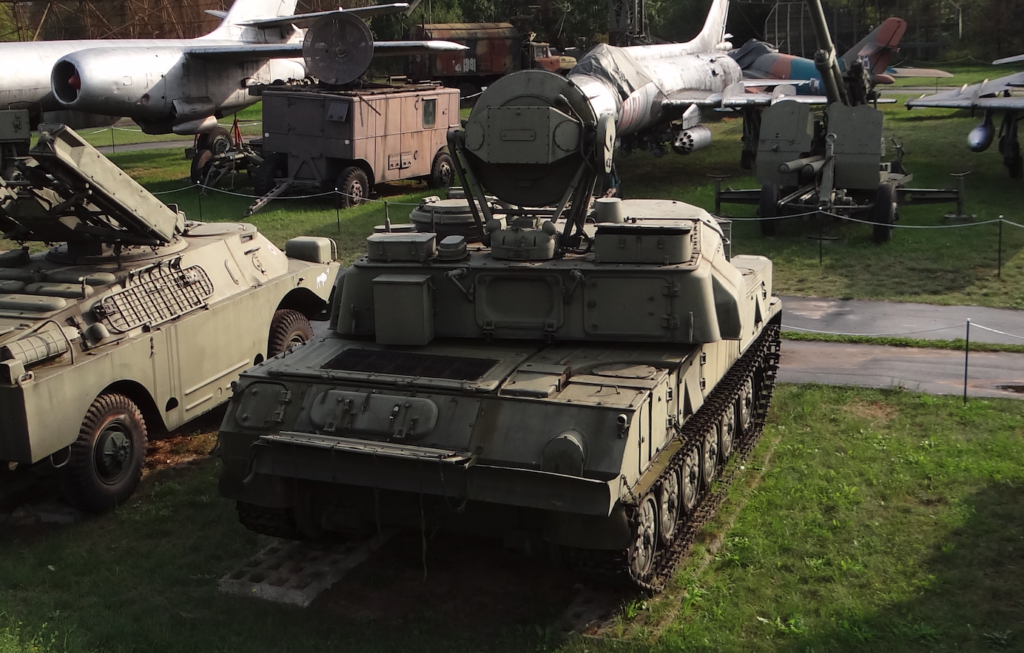Warszawa 2025-04-05
ZSU-23-4 self-propelled anti-aircraft gun.



ZSU-23-4 is a Soviet self-propelled anti-aircraft gun, tracked. Produced by Ulyanovsk Mechanical Plant. Crew of 4 soldiers. About 6,500 units were built.
The vehicle is equipped with a W-6R diesel engine, which is 4-stroke. Additionally, the vehicle has a DG4M-1 gas turbine, with a power of 280 HP, which is used to drive generators powering on-board equipment. The drive uses a mechanical transmission. The armor (hull) is made of rolled steel.
T-T ZSU-23-4 “Shylka” data: Length 6.30 m. Width 2.90 m. Height 2.20 m. Ground clearance 0.35 m. Combat weight 14,000 kg. Maximum speed 44 km/h. Maximum speed during firing is up to 25 km/h. Range on one refueling 450 km. Fording to a depth of 1.00 m. Width of the crossed ditch up to 2.80 m. Height of the vertical obstacle up to 1.10 m. Approach angle 30 degrees. Armament consists of 4 coupled, automatic anti-aircraft guns AZP-23 caliber 23 mm. Barrel length 2010 mm (87.3 calibers). Initial velocity of the projectile 970 m/s. Projectile weight 178 grams. Theoretical rate of fire 2,000 shots per minute. Practical rate of fire 400 shots per minute. Effective horizontal range 2,500 m. Effective vertical range 2,000 m.
The ZSU-23-4 “Shilka” vehicle is armed with 4 AZP-23 cannons of caliber 23 mm. The vehicle was developed in the Moscow State in the period 1957-1961, in the Astrov Design Bureau. The name ZSU comes from the abbreviation Zenitnaya Samochodnaya Ustanovka – Зенитная самоходная установка – anti-aircraft self-propelled gun. The word Shilka is the name of a Russian river, which is a left tributary of the Amur River. The number 23 denotes the caliber of 23 mm. The number 4 denotes the number of cannons. The vehicle does not have the ability to swim. In NATO code the vehicle was given the name Awl, or awl.
In the 1950s, the basic armament in the CCCP was the PLOT wz. 1939 37 mm cannon, and the PLOT self-propelled ZSU-57-2 cannon. This was a time of fascination with rockets and radars. However, local conflicts indicated that barrel weapons would be in use for a long time. It was decided to develop a PLOT vehicle that would use the radar for operating barrel weapons as a sight. An additional requirement was the ability to operate in terrain contaminated with ABC weapons.
It was assumed in advance that the vehicle would be based on the GM-575 tracked chassis. This was the chassis developed for the PT-76 amphibious tank. The barrel weapon was the towed ZU-23-2 artillery set, which had two AZP-23 coupled 23 mm cannons. A radar with a parabolic antenna for tracking targets was used as a sight. Guidance, calculation of the target’s flight parameters and shooting were fully automatic. The method of finding the target, determining its position and current speed, was carried out using the on-board radar type 1RL33 / RPK-2 Tobol. The radar operates in the microwave Ku band, with a range from 14.6 to 15.6 GHz. The radar is able to detect a target from a distance of 20,000 m and track it at a distance of up to 6,000 m. A type 1A7 calculator was used, which is an electromechanical device. The calculator is powered by alternating current. The executive system is electrohydraulic actuators. Manual control was left in case of failure. The guns are cooled by a water system. The guns are automatic, reloaded with the energy of powder gases discharged through a side hole in the barrel and locked with a wedge lock, through its vertical movement. The guns are powered by projectiles from a belt, with separable cells. The upper guns have a supply of 550 rounds, and the lower ones 450 rounds. Fire at targets can be conducted from a standing position or while marching, up to a speed of 25 km/h. It is recommended to fire in short bursts.
The gas turbine provides power to the vehicle’s systems, except for traction. The exhaust gases from the turbine are very hot and it is forbidden to stand closer than 15 m behind the vehicle. Usually, vehicles operate in groups, maintaining a distance of about 200 m between each other and being 400 m from the protected object.
The ZSU-23-4 vehicles entered service with the Red Army in 1964, and later also with other Warsaw Pact armies, including the Polish Army, and Arab states. The vehicles were first used in combat in 1967, during the Six-Day War. Currently (2025), the vehicles are widely used on both sides of the military conflict in Ukraine. In Poland, the ZSU-23-4 “Szyłka” vehicles are presented in museums, for example the Polish Army Museum in Warsaw.
ZSU-23-4MP Biała vehicle.
The ZSU-23-4MP Biała vehicle was created in Poland based on the ZSU-23-4 vehicle. The prototype was developed in 2000 by the Research and Development Center in Tarnów, with the participation of the 4th District Technical Workshops in Żurawica. It was decided to use systems and devices developed by the Polish Defense Industry. The PLOT vehicle passed field tests. Production began in 2005. In December 2005, an order was issued by the Chief of the General Staff of the Polish Army to accept ZSU-23-4MP Biała vehicles into the army’s armament. The contract included the modernization of up to 70 units, at a rate of 3-4 vehicles per year. The vehicle was advertised as a cheaper alternative to PLOT vehicles compared to foreign designs. The vehicles built entered the armament of the 10th Armored Cavalry Brigade. There were plans to modernize another 7-10 vehicles. Decisions were made to modernize 20-30 ZSU-23-4 “Szyłka” vehicles to the ZSU-23-4MP Biała standard by 2020.
The vehicle is equipped with a 6-cylinder, 4-stroke W-6R diesel engine with a power of 280 HP (210 kW), at 2,000 rpm and a PANDA 18 NE, 18.7 kW generator. A mechanical transmission is used. The vehicle is operated by 3 soldiers. The vehicle is armored. The armor is made of steel plates, 8.3-9.2 mm thick, joined by welding. The main armament is 4×23 mm AZP-23 liquid-cooled cannons. Ammunition supply 2,000 rounds. Additional armament 4 anti-aircraft sets of the Grom type. With sub-caliber ammunition, the effective fire range increases by 500 m.
T-T data of the PLOT ZSU-23-4MP Biała vehicle: Length 6.54 m. Width 2.95 m. Height 2.25 m. Combat weight 20,500 kg. Maximum speed 50 km/h. Range 450 km.
The vehicle is richly equipped to operate in various terrain and weather conditions. Night vision devices: TWNO-2 and TKN-1T. Infrared spotlight PG-125. Radio communication station R-123. On-board telephone R-124. Navigation type TNA-2. Protection device against ABC weapons. Fire protection system. Ventilation system. SKO sight with automatic target tracking system during the day and at night.
Thanks to night vision devices, the vehicle can be used at night. The driver has a night vision device type TWNO-2, with a range of 60-100 m. The vehicle commander has a night vision device type TKN-1T, with a range of 200-250 m. The terrain is illuminated by an infrared spotlight PG-125. The vehicle is equipped with navigation equipment type TNA-2. The Soviet R-123 radio communication station and the R-124 on-board telephone were left.
The vehicle has an optoelectronic Fire Control System (SKO) with an automatic target tracking system during the day and night. The operation of this system is undetectable by the enemy. The barrel armament has been left unchanged. However, a set of Grom anti-aircraft missiles, in the amount of 4 copies, was added. The range of these missiles is 5,500 m.
The vehicle is operated by 3 soldiers. The vehicle is armored. The armor is made of steel plates, 8.3-9.2 mm thick, joined by welding. The GM-575 chassis is welded from armor plates. The hull of the vehicle is divided into three parts. In the front is the driver-mechanic’s station. In the middle part there is a compartment for the other two crew members. The rear compartment is intended for the engine, transmission, turbine and fuel tanks.
Written by Karol Placha Hetman

